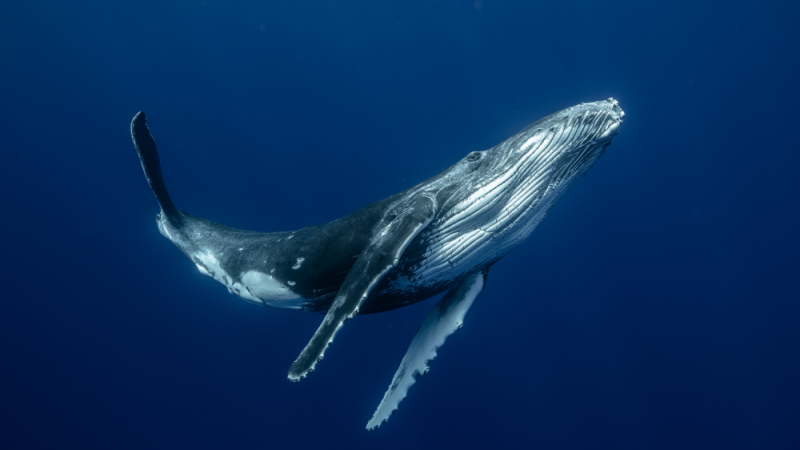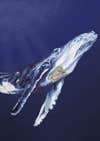We finally know how baleen whales make noise

Baleen whales, including today’s blue, humpback, and fin whales rely on sounds to live in their watery world. Their songs must be able travel far in the murky, dark ocean so that they can find their kin and migrate hundreds of thousands of miles. In the more than 50 years that scientists have been studying whale song, it’s remained unclear what physical structures baleen whales use to make noise until now. A study published February 21 in the journal Nature finds that baleen whales evolved unique parts in their larynx that create their complex vocalizations.
[Related: The planet’s first filter feeder could be this extinct marine reptile.]
“Whales are absolutely amazing creatures, they are the biggest animals to have ever lived. They’re way bigger than the largest dinosaurs, they can dive deep, and are very social,” Coen Elemans, study co-author and a voice scientist at the University of Southern Denmark, tells PopSci. “Because it is so difficult to find another animal in a huge ocean, many of these behaviors are guided by sound. Thus understanding how they make sound is crucial to understand the biology of whales in general.”
Toothed whales vs. baleen whales
Whales fall into two main groups–toothed whales (Odontocetes) and baleen whales (Mysticetes). Toothed whales include, orcas, sperm whales, dolphins, and porpoises. Many of these species have visible teeth that they use to crush their prey.
Baleen–or whalebone–is a hard substance made up of keratin. It grows from the whale’s upper jaw in plates with bristle-like fringes. It works like a sieve to filter out the small fish or zooplankton that it eats.
“Baleen whales make sound with their larynx and toothed whales in their nose,” explains Elemans. “Both use the same mechanism of vibrating tissues just like human vocal folds, but with completely new structures.”
Evolving new vocal structures
In the study, the team examined three stranded whales. Each specimen was from different baleen species–sei, common minke, and humpback whale. Whales that strand themselves on the beach can provide researchers with an opportunity to study their anatomy closer. After the larynx of each whale species was extracted, the team built a computational model of the entire whale larynx in the lab. The model included accurate 3D shapes of the muscles surrounding the larynx, which made it possible to simulate how the sound frequency is controlled by muscle movement.

They found that baleen whales evolved to produce sound with the vibrations of specific internal structures in the larynx, that toothed whales do not have. These specialized structures in baleen whales allow for sound to be produced and air recycled, while preventing the whales from inhaling water.
While both types of whales can still produce sound with their larynx, baleen whales have novel structures that do this. They use cartilages called the arytenoids that are also found in the human larynx. The arytenoids change the position of human vocal folds. In baleen whales, they appear as large, long cylinders at the base of a U-shaped rigid structure that covers the full length of the larynx, instead of small cartilage. This helps keep their airway open when moving large amounts of air through their massive bodies and not choke.

“The toothed and baleen whales evolved from land mammals that had a larynx serving two functions: protecting the airways and sound production,” Tecumseh Fitch, a study co-author and biologist at the University of Vienna in Austria, said in a statement. “However, their transition to aquatic life placed new and strict demands on the larynx to prevent choking underwater.”
Turn it down
While the study showed how baleen whales produce low frequency vocalizations for the first time, thesound production that they have honed over millions of years of evolution is becoming threatened in an increasingly noisy ocean.
“They can’t make sound very deep and most species can’t make high frequencies,” says Elemans. “This limits the range of their communication. On top of that, these depths and frequencies overlap with human made noise in the oceans, such as boat traffic, and thus the whales cannot escape this noise by singing for example higher.”
[Related: Is it loud in the ocean?]
The authors cite the flurry of conservation and political activity in the wake of the first acoustic recordings of humpback whale song in 1970. Roger and Katy Payne’s album Songs of the Humpback Whale was considered so important that selections from it were included on a record aboard the Voyager 1 spacecraft, to give any extraterrestrials who may find the spacecraft an idea of what life on Earth is like. The oceans have only gotten noisier since the 1970s, and similar conservation efforts are needed to reduce noise.
“We need strict regulations for such noise, because these whales are dependent on sound for communication,” Elemans said in a statement. “Now we show that despite their amazing physiology they literally cannot escape the noise humans make in the oceans.”










